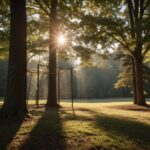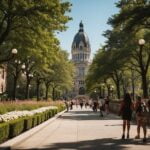Lower North Philadelphia, a significant region of Philadelphia, is known for its vibrant urban energy and deep historical roots. This region stretches from Vine Street to Glenwood Avenue and from North Broad Street to the Schuylkill River. It is a showcase of Philadelphia’s diverse urban life, displaying a rich amalgamation of history, culture, and architectural splendor.
The region is divided into distinct neighborhoods, each boasting its unique character and community spirit. From historic Fairmount to artistic Northern Liberties and the lively Temple University campus in Cecil B. Moore, diversity and vibrancy define this part of the city.
The story of Lower North Philadelphia is woven into the city’s history, with its neighborhoods contributing to the city’s growth and development over the years. Alongside this, the region is home to a diverse population, reflecting Philadelphia’s multicultural ethos and adding to the city’s charm.
Lower North Philadelphia also features prominent landmarks such as the Philadelphia Museum of Art, the Eastern State Penitentiary, and Temple University, showcasing the region’s contributions to culture, education, and history. This exploration will take you through Lower North Philadelphia’s neighborhoods, history, demographics, and notable features, demonstrating its essential role in the City of Brotherly Love.
Neighborhoods
Each neighborhood in Lower North Philadelphia offers a distinctive slice of city life. From the historic houses of Strawberry Mansion to the dynamic art scene in Northern Liberties, there is a wealth of diversity waiting to be discovered.
Brewerytown
Brewerytown is an iconic neighborhood named after the many breweries that dotted the area in the late 19th and early 20th centuries. Today, it’s known for its rich history, diverse population, and blossoming commercial corridors. Brewerytown’s residential streets are notable for their distinct Philadelphia-style row homes, while its main avenues like Girard Avenue, offer a variety of local businesses and dining options.
This neighborhood is also seeing a cultural revival with a steady influx of artists, musicians, and young entrepreneurs contributing to its vibrant, creative atmosphere. Numerous art studios, music venues, and boutique businesses have sprouted, turning Brewerytown into a hotspot for creative energy and innovation.
Additionally, Brewerytown is home to numerous parks and green spaces. Fairmount Park, one of the largest urban park systems in the country, is right on its doorstep. These elements, combined with its rich brewing history, make Brewerytown a unique and attractive neighborhood in Lower North Philadelphia.
Cecil B. Moore
Cecil B. Moore, named after the prominent civil rights leader and Philadelphia lawyer, is home to the bustling campus of Temple University. The university’s influence is visible in the neighborhood’s vibrant mix of students, faculty, and long-term residents. The neighborhood is a hub of academic activity, with libraries, research facilities, and historic college buildings lining its streets.
Beyond the academic world, Cecil B. Moore has a rich cultural legacy. This is where you’ll find the historic Uptown Theater, a hotspot for African American music in the mid-20th century. The neighborhood is also known for its strong community spirit, visible in its active civic associations and community centers.
The commercial corridors in Cecil B. Moore are a mix of student-centric businesses, local shops, and international cuisine, reflecting the neighborhood’s diverse demographics. The blend of academic vitality, historical significance, and community spirit makes Cecil B. Moore a dynamic part of Lower North Philadelphia.
Hartranft
Hartranft is a diverse and close-knit community located east of Broad Street. The neighborhood is filled with narrow streets lined with brick row houses, showcasing Philadelphia’s architectural style. Hartranft’s central location makes it an accessible area, with numerous bus lines and subway stations connecting it to the broader city.
Hartranft has a strong community ethos, seen in its active community centers and frequent neighborhood events. The John F. Hartranft School, a Kindergarten to 8th grade school, serves as a focal point for community engagement. The school hosts numerous local events and activities, encouraging community involvement and fostering a strong sense of neighborhood identity.
One of Hartranft’s notable features is the substantial amount of green space it offers in the form of parks and playgrounds. The most significant is the Athletic Recreation Center, a large public park with sports fields, a playground, and an indoor facility. Hartranft’s accessibility, community spirit, and ample green space make it a standout neighborhood in Lower North Philadelphia.
Ludlow
Ludlow, nestled between Cecil B. Moore and Olde Kensington, is a neighborhood known for its historic charm and community-centric atmosphere. Its streets are filled with two-story row homes that reflect Philadelphia’s architectural tradition, creating a sense of continuity with the city’s historical roots.
This neighborhood is a haven for those seeking a quiet residential area that’s still within reach of vibrant commercial corridors. Ludlow’s proximity to the bustling areas of Fishtown and Northern Liberties offers residents a wide range of dining, shopping, and entertainment options just a short walk or bike ride away.
Community engagement is strong in Ludlow, with several active civic associations and community development corporations working to improve the neighborhood. Local gardens and murals add to the neighborhood’s charm and foster a sense of community pride. Ludlow’s blend of historic charm, convenient location, and community involvement make it a unique piece of Lower North Philadelphia’s mosaic.
Poplar
Poplar, located west of Northern Liberties, is a historic neighborhood undergoing rapid change. It boasts a rich architectural landscape, featuring 19th-century churches and historic row homes. This neighborhood also showcases modern apartments and condominiums, reflecting Poplar’s ongoing transformation.
Poplar’s close proximity to Center City and the thriving areas of Fishtown and Northern Liberties makes it a convenient neighborhood for residents seeking a balance of residential calm and urban vibrancy. The neighborhood is also well-connected by public transportation, adding to its accessibility.
The neighborhood is also home to several parks and recreation centers, offering residents ample opportunities for outdoor activities. One of the neighborhood’s most notable features is the Spring Garden Street Greenway, a project set to transform Spring Garden Street into a green, urban commons. Poplar’s combination of historic charm, ongoing development, and outdoor amenities makes it an engaging part of Lower North Philadelphia.
Sharswood
Sharswood, nestled between Brewerytown and Cecil B. Moore, is a historic neighborhood named after the Sharswood School, a local K-8 school in the area. It is primarily residential, filled with Philadelphia-style row homes and features several parks, playgrounds, and community gardens, offering ample green space for residents.
This neighborhood has seen significant revitalization efforts in recent years, with the Philadelphia Housing Authority’s Sharswood/Blumberg Transformation Plan working to improve housing, community services, and infrastructure. As part of these efforts, new housing units, retail spaces, and community facilities have been developed, signaling an era of change for Sharswood.
Sharswood’s revitalization efforts, coupled with its close proximity to the vibrant Brewerytown and Fairmount neighborhoods, have made it an increasingly appealing neighborhood in Lower North Philadelphia. Its blend of residential charm, ongoing development, and community spirit make it a unique part of the city’s fabric.
Spring Garden
Spring Garden is a historic neighborhood known for its well-preserved, mid-19th-century homes and wide, tree-lined streets. The neighborhood gets its name from the Spring Garden District of Philadelphia, which was incorporated into the city in the mid-1800s. It’s located to the north of Center City, bordering Fairmount Avenue to the north, Broad Street to the east, and the Schuylkill River to the west.
The neighborhood is a diverse mix of families, young professionals, and artists, contributing to its vibrant community spirit. Spring Garden is also home to several institutions, including the Community College of Philadelphia and the School District of Philadelphia, adding to its educational vitality.
One of the defining features of Spring Garden is its proximity to a wealth of cultural institutions. The Philadelphia Museum of Art, the Rodin Museum, and the Barnes Foundation are all within walking distance, making the neighborhood a hub for arts and culture. The combination of historical preservation, diverse community, and cultural richness make Spring Garden an appealing neighborhood in Lower North Philadelphia.
Stanton
Stanton is a neighborhood located north of Cecil B. Moore. It’s primarily residential, characterized by rows of two-story, brick homes. Like many parts of Lower North Philadelphia, Stanton is a tight-knit community where neighbors know each other, contributing to its close community spirit.
Despite its primarily residential nature, Stanton is conveniently located close to the bustling areas of Fishtown and Northern Liberties, offering residents access to a variety of dining, shopping, and entertainment options. The neighborhood is also well-served by public transportation, making it easy to travel to other parts of the city.
Stanton is home to several schools and recreation centers, offering plenty of opportunities for community involvement and outdoor activities. With its tight-knit community, convenient location, and ample community resources, Stanton holds a unique spot in the fabric of Lower North Philadelphia.
Strawberry Mansion
Strawberry Mansion, located east of Fairmount Park, is a historic neighborhood known for its large, ornate homes from the Victorian era. The neighborhood gets its name from a historic house located in Fairmount Park, known as the “Strawberry Mansion.”
The neighborhood has a strong sense of community, with active neighborhood associations and community development corporations working to improve the area. Despite its urban setting, Strawberry Mansion offers residents ample green space with its close proximity to East Fairmount Park, one of the largest urban park systems in the country.
Strawberry Mansion is also home to several historic landmarks and cultural institutions, including the historic Laurel Hill Cemetery and the Strawberry Mansion Reservoir. The neighborhood’s combination of historic charm, community spirit, and access to green spaces makes it a unique part of Lower North Philadelphia.
Yorktown
Yorktown is a neighborhood bounded by Cecil B. Moore Avenue, North Broad Street, Girard Avenue, and 11th Street. It’s known for its distinctive mid-century, single-family homes and its close-knit community. This neighborhood, developed in the 1960s, represents a departure from the typical row home style prevalent in much of Philadelphia.
Despite being primarily residential, Yorktown’s central location offers residents easy access to Center City and surrounding neighborhoods like Northern Liberties and Fishtown. The neighborhood is also home to several educational institutions, including Temple University and the Philadelphia High School for Creative and Performing Arts, adding to its academic atmosphere.
Yorktown is notable for its active neighborhood association, which organizes community events and works to maintain the neighborhood’s unique character. The blend of mid-century residential charm, central location, and community involvement make Yorktown a distinctive part of Lower North Philadelphia.
Fairmount
Fairmount, often referred to as the “Art Museum Area” due to its proximity to the Philadelphia Museum of Art, is a neighborhood rich with history, culture, and natural beauty. The neighborhood is filled with a mix of modern and historic homes, bistros, gastro pubs, and boutiques, offering a variety of lifestyle options for residents.
Fairmount is also home to several parks and green spaces, most notably the eastern edge of Fairmount Park, offering residents numerous recreational opportunities. The park features the famous Fairmount Water Works and hosts several citywide events throughout the year, including concerts and races.
The neighborhood’s proximity to a wealth of cultural institutions and its vibrant dining and shopping scene make it a sought-after location in the city. With its blend of historical, cultural, and natural amenities, Fairmount holds a unique place in Lower North Philadelphia.
Northern Liberties
Northern Liberties, once a manufacturing district, is now one of Philadelphia’s most vibrant and progressive neighborhoods. It is known for its eclectic mix of historic buildings, contemporary architecture, and street murals. The neighborhood’s revitalization over the past couple of decades is visible in its bustling commercial corridors, filled with indie boutiques, art galleries, and a variety of eateries and bars.
The neighborhood is home to the historic Schmidt’s Commons, a mixed-use development featuring a beer garden, restaurants, and locally-owned shops. Northern Liberties also hosts several annual events and festivals, adding to its lively atmosphere.
Northern Liberties is also known for its strong sense of community, with active neighborhood associations and numerous community gardens. This blend of historic charm, contemporary lifestyle, and community spirit make Northern Liberties a standout neighborhood in Lower North Philadelphia.
History
Lower North Philadelphia’s history is a captivating narrative of transformation. From William Penn’s original survey of Philadelphia, which included much of what is now Lower North, to the region’s industrial boom during the 19th century, and the subsequent deindustrialization, the area has continually evolved. Many neighborhoods like Northern Liberties and Brewerytown have reinvented themselves after decades of decline, ushering in a new era of growth and cultural vitality.
Demographics
Lower North Philadelphia is a melting pot of cultures, reflecting a diverse array of demographics. The area has a significant African American community, along with growing Hispanic and Asian populations. The presence of Temple University also brings in a youthful, academic vibe to the region.
Notable Features
From historic landmarks like the Eastern State Penitentiary to cultural institutions like the Philadelphia Museum of Art, Lower North Philadelphia has many unique features. The area’s thriving arts scene, particularly in neighborhoods like Northern Liberties and Brewerytown, is a testament to the creative spirit of the city. The presence of Temple University, one of the nation’s largest educational institutions, also adds a vibrant, youthful energy to the area.
Conclusion
Lower North Philadelphia is a compelling blend of old and new, where history and modernity intersect in engaging ways. From its rich past to its dynamic present, each neighborhood has a unique story to tell. As part of your journey through Philadelphia, make sure to explore more about the city in the comprehensive guide, “Discovering Philadelphia: A Comprehensive Guide to the City of Brotherly Love.” This guide is a treasure trove of information, providing you with an in-depth look at the city’s many fascinating facets.





